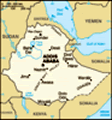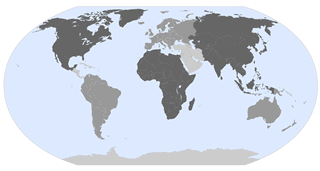Advertisement
Published: November 16th 2015
Back in Addis Ababa I planned my visit to the south. Asking for information at the tour agencies was worthless, since they charge a ridiculous amount and they tell you that it’s almost impossible to go to the Omo Valley by yourself, which is a lie! I stayed two nights in Addis Ababa to rest, did some laundry and wrote a blog-entry. I also went to the Ethnological Museum, which used to be a palace of Emperor Haile Selassie. Today it’s part the Addis Ababa University that opened in 1949. The museum displays several old, (religious) artwork, handicrafts etc. This particular part of the museum displays everything in order, starting with birth and continuing to childhood and so on. You'll also get to see Haile Selassie's bedroom and bathroom among others.
At the hotel in Addis Ababa, since I arrived, I met Abel who is an Ethiopian born and raised in the Netherlands. He did his apprenticeships at the hotel and decided to move to Ethiopia, his roots. He works and lives at the hotel and is a truly friendly and smart guy I always spoke to. I left my big backpack with him and took only my small one to
the south.
I took a bus from Meskel Square to
Awassa (or Hawassa), a city of roughly 150 000 people. The city itself doesn’t have much in particular to see, but it’s located at the shores of Lake Awassa. My guesthouse was a 2 minute walk from the shores of the lake. There is a long path along the shore with several small cafes and restaurants. I immediately liked the place and the atmosphere, especially at sunset it was really nice. Many marabous and other type of birds are present in the area. Unfortunately the electricity went off (something that happened often throughout my stay in Ethiopia) and it stayed that way for the whole night. The guesthouse had a generator, which they turned off around 10pm. In the morning I walked with a few Germans towards the Fish Market. I knew you had to pay a 20 Birr entrance fee, but a local I spoke to the day before clearly told me that you do not need a guide. The people at the market insisted that we need to a hire a guide but I firmly refused and they left us alone. The market was an interesting
place to see, but it wasn’t big. Many fisherman were working on their nets and boats along the shore; it was just nice to see people doing their thing. We had a small breakfast at the market and then left. I grabbed my stuff at the guesthouse and took a bus to
Shashemene (or Shashamane). This little city is well-known for its Rastafari-settlement. Emperor Haile Selassie gave 2 square km. of land to Rastafaris and allowed many from the Caribbean, mostly Jamaica, to move to Shashemene (the repatriation). I was recommended by the Israeli travellers I met in the north, to stay at Ras Lumumba David’s place. He has a nice garden where he grows some food and he rents a couple of rooms too. He arranged a bajaj-driver to take me around Shashemene for a bit. We first stopped at Nyahbinghi Tabernacle which consisted of a small museum, where one of the rasta’s (Jamaican) showed me around and told me about the place. There was also like a small church there, in round form. We went to the Ras Teddy Dan Art Gallery but unfortunately it was closed. Same goes for the Bobo Shanti's place.
Ras Hailu's Banana Art
Gallery was very interesting! Ras Hailu Tefari (formerly known as Raymond Payne) was born in Aruba but moved to St. Vincent & the Grenadines at the age of 1 and grew up there. His mother was from Aruba and his father from St. Vincent. His mom used to live in the Netherlands until she passed away about 10 years ago and he has a sister living in Bonaire. Ras Hailu lives in Shashemene now and is a well-known “banana artist”. He creates all his work by using banana leaves, flowers and barks. No colours, stains or dyes are added. All the tones, shades and effects are natural. He obtained a college diploma in art & design in the UK and former presidents Lusinchi (Venezuela), Regan (USA) and Kaunda (Zambia) prize his work in their homes. He said I was the first person from the ABC islands to visit his workplace. It was a truly interesting encounter! After buying a small souvenir at a shop, I went back to Ras Lumumba’s place where more rastas came and we all sat around the fire for some time.
The next morning I left early to Arba Minch. I used this
city just as a stop-over to travel further south, since the buses to Jinka leave at 6am. I made sure to buy a ticket immediately, spent the night in Arba Minch and boarded the bus the next morning. After about 6 hours I arrived in
Jinka, a town of 30 000 people in the Omo Valley, a region well-known for its many tribes. I went to Jinka hoping to see one or two tribes, I did not have the necessity of seeing more tribes. Some tribes can be visited by public transport, but the buses don’t run everyday to all villages so the best way is to arrange a driver to take you around. This is not cheap but you can always share the costs with others. Some guys at the guesthouse arranged a driver for me who was already travelling with two Czech guys. I felt that I was ripped off a little in order to get this because I know that these guys set their own “commissions”. It made me a bit angry but on the other hand it would have been difficult to arrange something else for the days to come. I took a walk around Jinka
and visited the market, where I got a chance to see people of the Mursi tribe. They are known for the plates they insert into their pierced bottom lips. It’s just a decoration to make to women of the tribe look beautiful. Apparently the members of this tribe can get a bit aggressive and the other tribes are scared of them.
The next morning they picked me up and we drove to the town of
Demeka, where there was a Saturday market going on. People of the Hamer-tribe (or Hamar) can be seen at the market selling their fruits, vegetables and more. The people from this tribe are really friendly and always greet with a smile. The driver arranged a tour-guide, Ode, who walked around with me the rest of the day. The women of the Hamer tribe apply a certain red earth in their hair, giving their hair a distinctive colour. A bull-jumping ceremony would happen in that afternoon so we stayed in Demeka. The bull-jumping is done by teenage boys in order to become adults. We went to a place where many from the tribe gathered and guys from the tribes were painting their faces to
get ready for the ceremony. The guys with their faces painted are the whippers (Maza's) and they whip the women with a tree branch. The women love this and ask for more, even though they have marks and blood on their backs. Bizarre to see! It's still not completely clear why the women are whipped, but it is to show how strong they are since they can endure childbirth. It's mostly the relatives of the boy jumping the bulls who get whipped. Once at the village the whipping continued, while many of the women were dancing and singing in a circle. Apparently they had to wait for one bull to be brought from another village, so we waited and waited for long. I became friends with two brothers from the tribe: 15 year old Chicho and 16 year old Hailu, who was the one to do the bull-jumping. I took a picture with them and for some reason they liked me a lot. Especially Chicho, who would always come and sit next to me, put his arm around my shoulder and hold my hand when we walk. He took off his wrist-brand, typically used by the tribe, and gave it
to me as a present without expecting anything in return. How cool was that, wow! Sunset was nearing and we heard that the ceremony was moved to the next day, since the bull did not arrive from the other village. The brothers and their family wanted me to stay in the village for the night, but apparently it’s not allowed by the government so I didn’t. I had dinner with Chicho and Ode in Demeka and in the morning they came early to see me at the pension. We walked to the village and again waited quite long, until that one bull finally arrived from the other village. First Hailu was surrounded by other guys from the tribe, preparing him for the jump. They lined up about 12 bulls and Hailu had to run naked over the back of the bulls four times without falling. For the rest of the day I just chilled in Demeka with Chicho and Ode (who was translating since Chicho speaks very limited English) and I left the next day. Before leaving I gave Chicho some money, with which he bought new pants that he needed. The experience with this tribe was truly amazing, no
other words to express it! It's definitely one of the highlights of this whole trip since I left Curaçao end of June 2013. I wish I could bring the brothers to Curaçao one day for a visit. Via Ode and the driver I’ll try to keep in touch with these brothers and maybe see them again one day.
I spent another night in Arba Minch, from where I boarded a bus back to Addis Ababa. I shortly met Tamirat for dinner and some beers and I prepared myself for the next stage of the journey.
Ethiopia was a great experience and I would recommend everyone to visit one day: beautiful people, landscape, interesting culture and history, nice food...and it is not very expensive (not the cheapest destination either). From Addis Ababa I took another Ethiopian flight towards the south. More in the next blog-entry!
Advertisement
Tot: 0.066s; Tpl: 0.019s; cc: 11; qc: 26; dbt: 0.0185s; 1; m:domysql w:travelblog (10.17.0.13); sld: 1;
; mem: 1.2mb





























Dancing Dave
David Hooper
Omo Valley
You obviously are having a fantastic sojourn through Ethiopia Elton. Isn't Lake Awassa stunning in the early morning light? Your time in Shashamane...how lucky are you? Jinka which is one of my favourite place names. The Mursi & Hamar. But the highlight sounds like your bonding with the Hamar...bull jumping and as brothers. Wow. Maybe you will agree that Ethiopia is truly a jewel of Africa.